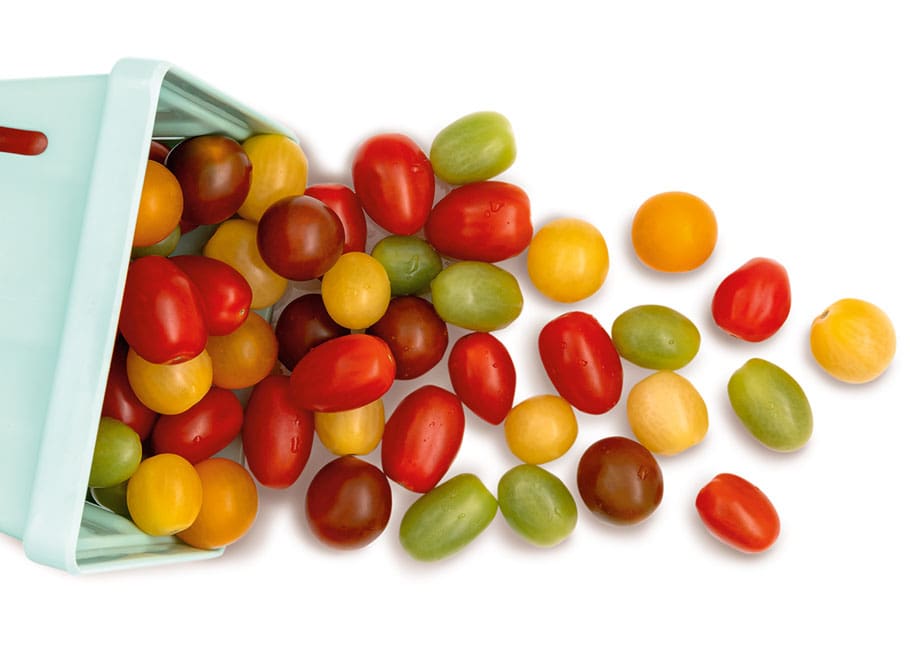
© COSTCO CANADA
Growing success
Top-tasting tomatoes from Costco’s suppliers to your table
by ANDREA TOMKINS
There’s a story behind the multi-coloured tomatoes at Costco, and it’s a good one.
An amazing amount of time, energy and teamwork goes into these packages of sweet and juicy little treats. The container you just popped into your cart simply because you know they are healthy and delicious (and the kids love them in their lunch boxes) is the result of a real passion for the product and years of development.
“It’s a very successful product—a real success story,” says Stéphane Desrochers, a buyer on Costco Canada’s produce team.
Tasting, testing and time
Costco’s goal is a simple one: to find the best grape and cherry tomato varieties to bring to Costco members for the best possible price.
How does the team find the top tomatoes—that perfect balance of sweetness, acidity and flavour that we all crave? It involves a lot of tasting, a lot of testing and a lot of time.
Selecting and breeding for the desired taste, colour and quality involves crossbreeding different varieties of tomato plants to create new cultivars. It’s a process that can take a surprisingly long time. In fact, the team samples tomatoes years before they’re even available to be grown in a commercial setting.
“The process of bringing a new tomato variety to the Costco member can take over seven years,” says Desrochers. “The selective breeding of generations of plants—it takes time!”
It’s also a journey that takes the produce team to cities across Canada and around the globe, to meet with seed development companies in Spain, Italy, Holland, Japan, the United States and Mexico.
Consistency is crucial
There are many aspects to this process that members may not be aware of. For example, if the team is pitched a great-tasting tomato that’s grown in Spain, the next step is to see how well it yields and tastes when grown in Canada. “That same seed, grown here, could bear fruit that has a completely different flavour. If successful, it’s packaged and launched in select warehouses for member feedback,” says Desrochers.
Another crucial part of the job is ensuring each variety tastes consistently the same—no matter where it’s grown, no matter the season—so members can always bring home a taste of summer.
In the summertime, Costco tomatoes hail from Ontario and British Columbia. In the winter, they’re grown in Mexico. Before that transition happens, however, the Costco buying team conducts thorough taste tests to make sure the flavour and quality remain top-notch.
“We want Costco members to be able to buy tomatoes during the peak of a beautiful Canadian summer and have it taste the same in the winter when we’re pulling product from Mexico,” explains Desrochers. Every year, the winter batch from Mexico is tasted side by side with the Canadian batch. Palmer says, “They need to meet our expectations so that it’s consistent and members don’t feel that they’re losing out on that great Canadian flavour.”
Costco’s packages of multicoloured tomatoes contain six varieties in shades of red, orange, yellow and green, and those varieties remain fairly consistent. The team chooses these varieties, and the suppliers are allowed to deliver only those six—no substitutions. Again, it’s about consistency.
Desrochers adds that the buying team tastes approximately 400 different tomato varieties during the selection process. Buyers are also looking for a tomato with the same high flavour as, but hopefully a higher yield than, the red grape tomato.
“We are ‘flavour first,’” says Desrochers. “And I hope that members see how much time, energy and thought go into this process. We are very conscious about the products we offer to our members... it’s a selection that we really care about, and it’s a selection we truly believe in.”
Grape tomatoes can be a part of breakfast, lunch and dinner. Toss them in salads, add them to tacos and rice bowls, roast them and add to pasta or crusty French bread, serve them on a skewer with cubes of cheese, slice them and drizzle with olive oil and balsamic vinegar (and a bit of freshly ground pepper) or add them to omelettes. And, of course, they’re very good eaten on their own. For the best possible flavour, do not keep your tomatoes in the refrigerator.—AT


